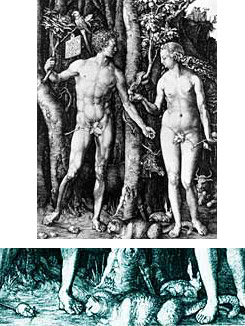David Ref

Albrecht Dürer, Adam and Eve, 1504 (below, part of the painting)
In the tenth century the cities of Europe and the Far East were overrun with cats. In written sources from the Middle Ages, cats were mentioned, sometimes casually and sometimes in regulations that dealt with them directly: for example, a document in which the average price of a cat in the market was determined (the same as the price of a dog), or regulations that determine the compensation that those who killed a cat must pay to its owner.
Soon, many myths, mostly negative, demonic, developed around the cats. The same qualities that made the cat a sacred animal in ancient Egypt, for example the fact that it was considered a female animal, caused the church in the Middle Ages to see it as a negative creature, possibly very close to the devil. For example, in show trials on behalf of the Inquisition, a cat was excellent evidence for the guilt of witches from among the community.
After the year 1000, the persecutions of witches and cats increased greatly. In various places the custom took root that on holidays one should hunt for stray cats, the embodiment of evil in this world, and exterminate them. A particularly gruesome invention was a cage into which several dozen cats were placed, with their tails tied to organ pedals. Playing the organ pulled the keys, and this caused the cats to howl and squeal in pain.
The fact that the cat was a relatively new animal in Europe caused the inhabitants of the continent to interpret some of its behaviors in an original way. For example, the restless response of cats to changes in barometric pressure, for example before a lightning storm, led to the development of legends in Eastern Europe, that the lightning is sent to expel evil spirits from the bodies of cats. At the beginning of a terrible storm, cats would be thrown out of the houses, to trap the lightning in their bodies.
Hatred and fear of cats was deeply rooted in Europe, and at least until the 16th century it was not acceptable to keep them as pets. Little by little the attitude towards them became a little more refined. In Albrecht Dürer's work from the beginning of the 16th century, in which the Garden of Eden is depicted, a cat and a mouse are lying at the feet of Adam and Eve - facing each other. The message is clear: before the expulsion from Heaven, even these two mythological enemies got along with each other. But the very appearance of the cat in a work of art suggests that perhaps it was no longer assigned out of disgust.
Since then, the attitude towards cats in Western society has changed a lot and their population has grown tremendously. However, polls show that even today cats attract extraordinary hatred. To their horror, as victims of rituals in extreme marginal classes, they have no competitors.
https://www.hayadan.org.il/BuildaGate4/general2/data_card.php?Cat=~~~923995477~~~195&SiteName=hayadan
